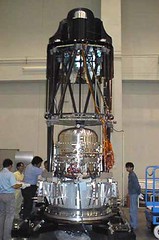
Suzaku carried three different kinds of instruments, allowing it to detect X-rays with energies from 0.2 to 700 keV (which translates to wavelengths ranging from 0.02 to 60 Ångstroms.
The detectors sit at the focal plane of Suzaku's five foil X-ray Telescopes (XRTs), four of which are used for the XIS and one for the XRS. These telescopes collect and focus X-rays so they can be detected by the XIS and XRS. With Suzaku, all of the telescopes are “co-aligned”, which means that they all watch the same part of the sky at the same time. With some satellites astronomers have to chose which detector they want to use at a given time, but with Suzaku, they don't have to choose – all of the instruments can see the same part of the sky.
Use the links above to learn a little more about each of the Suzaku instruments, or visit the main Technology page to learn how astronomers capture X-rays and about how each of these detectors work.